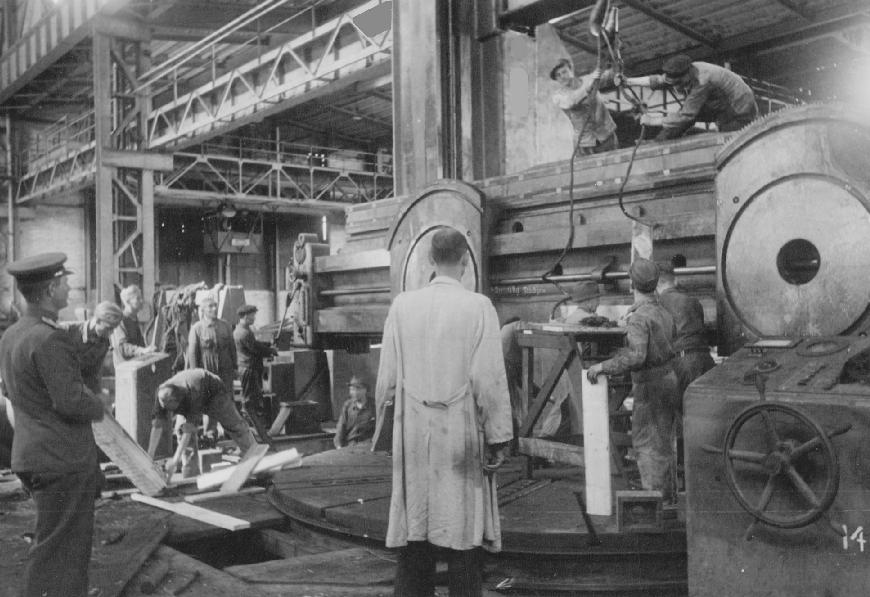
World War II Germany: Soviet Occupation--Reparations

Figure 1.--Here a Soviet officer, perhaps a poliyical officer or NKVD odicer, in 946 supervizes the dismantling of a factory in the Soviet occupation zone for shipment back to the Soviet Union. The press caption read, "Europe Cnnot Afford Thi Germany: Reparations --Entire factories are dismantled. A Russian officer watches dismntling of he Schiess Defried machine-tool factory near Duesseldorf. The whole building is going to Russia." Pf couese the oviets did not ship buildings, but rather the insustrial equioment inside the German factory buildings.
|
|
After the NAZI surreder (May 1945), the different occupation powers quickly assumed authority in their respective zones (by June 1945). The initial plan was fir Allied and Soviet powers to adopt and pursue a common occupation policy, focused. Some policy goals were shared by Allies ans Soviets, such as denazification and demilitarization. The Allies and Soviets had, however, very different objectives. Allied policy as it developed was to prepare Germany to eventual joining Europe as a responsible, independent and democratic nation. Nothing could have been more different than Soviet (meaning stalin's) objectives. The Allies were not in complete areement on occupation policies, but all three of the Allies were differed fundamentally with Soviert objectives. It did not take long for the idea of a unified occupation policy to collapse. The Soviets and Allies developed theor own policies. Besides the political differences, one of the major differences was the issue of reparations. The Soviet Government persued a policy of reparations which included shipping whole factories to the Soviet Union. The NAZIs had devestated the western Soviet Union, Along with apauling attrocities, the NAZIs implemented a scorched earth policy, destroying factories, schools, hospitals, public buildings, as well as homes as they retreated west. The Soviets sought to use German factory equipment to help rebuild the Soviet economy. This is not to say there were no reparations in the Western zones, but the Soviet used reparations to a far greater extent than the Allies. They began disassembling the German industry that had survived the Allied bombing and shipping it back to the Soviet Union. They focused on arms industries and industries owned by the NAZI state. Also targeted were factories owned by NAZI party members and by war criminals were confiscated. One estimate suggesta that the industries seized by the Soviets consisted of approximately 60 percent of the total industrial capacity in the Soviet occupation zone. The remaining heavy industry (some 20 percent of total production) was claimed by the Soviet authorities. The new Sowjetische Aktiengesellschaften -- SAG (Soviet joint stock companies) were created for many industries not shipped to the Soviet Union. The remaining industries not confiscated were was nationalized, some 40 percent of total industrial production was left in private hands. It is unclear how beneficial the disassembled factories were to the Soviets. A German reader tells us, "It is said that then in Russia the machines got rusty as the Russians were not able to resettle them anymore." Soviet occupation forces were not supplied like the Western forces and there was much more living off the land. [Dulles] Trading arrangements and bater deals during the occupation were heavily waited in the Soviets favor durig the occupation era. The Soviet Zone (the future DDR) would have had seriously problems competing with the Western Zone (future DFR). The Sovit Zone was a largely agricultural area and the Soviet reparations further reduced the industrial sector. The East Germans during the Cold War would blame their economic performance on the Soviet reparations. This was certainly part of the problem, but it does not seemed to have dawned on dedicated Communiusts that Communism itself was at the heart of their problems.
Sources
Dulles, Allen W. "That was then: Allen W. Dulles on the occupation of Germany" Foreign Affairs (November/December 2003).
CIH -- WW II

Navigate the Boys' Historical Clothing Web Site:
[Return to Main Soviet occupation zone page]
[Return to Main World War II German occupation page]
[Return to Main World War II German aftermath page]
[Return to Main Cold War page]
[Biographies]
[Campaigns]
[Children]
[Countries]
[Deciding factors]
[Diplomacy]
[Geo-political crisis]
[Economics]
[Home front]
[Intelligence]
[Resistance]
[Race]
[Refugees]
[Technology]
[Bibliographies]
[Contributions]
[FAQs]
[Images]
[Links]
[Registration]
[Tools]
[Return to the Main World War II page]
Created: 7:48 PM 12/6/2015
Last updated: 7:48 PM 12/6/2015



